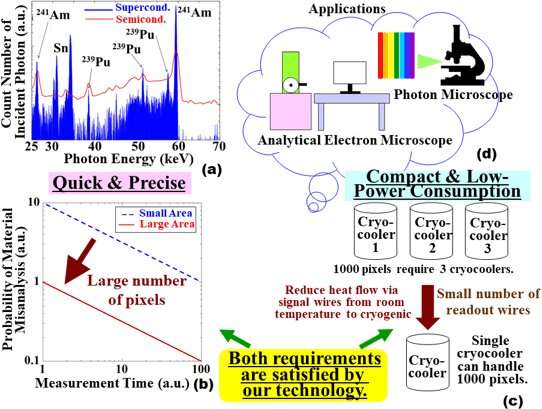A readout circuit that drastically increases the number of pixels in superconducting detectors

Superconducting detectors exhibit much lower noise than other (e. g. semiconductor) detectors and can detect weak low-frequency magnetic fields, electromagnetic waves from millimeter waves to X-rays and gamma rays, and energy particles. Thus, they have been used in magnetoencephalographs, magnetocardiographs, analytical electron microscopes, astronomical observation receivers, and so on. However, because they have low detection efficiency of incident signals due to their much small light reception area compared to room temperature detectors, imaging is conventionally performed by scanning a small number of pixels, resulting in long measurement time that is a problem for general applications.
The researchers, in collaboration with the University of Tokyo, have developed a readout technology for superconducting detectors. The developed technology that can load a signal of 1,000 pixels or more on a single readout wire, which is 5 times larger than a conventional technology.
Superconducting detectors can precisely measure the energy of single photons and particles and the intensity of weak electromagnetic waves, so they are used for long time, precise observation of weak electromagnetic waves coming from space, but there have been delays in increasing the number of pixels necessary to reduce measurement time. The main reason for this is that there is a limit to the number of pixels that can be multiplexed on a readout wire connecting a cryogenic multi-pixel detector and a room temperature signal processor. Increasing the number of readout wires in order to increase the total number of pixels results in greater heat flow via readout wires, making it necessary to strengthen a cryocooler, which in turn increases the volume, power consumption, and price of the whole system. The developed technology consists of multiple room temperature signal processors operating in parallel, and converts information from all pixels at the cryogenic stage into different frequency bands for each room temperature processor, loading these all together on one readout wire. This dramatically increases the number of pixels that can be loaded, which is expected to contribute to decreasing measurement time, volume, power consumption, and cost of superconducting-detectors-based analytical electron microscopes, radiation spectrometers, photon microscopes, etc.
Provided by Advanced Industrial Science and Technology